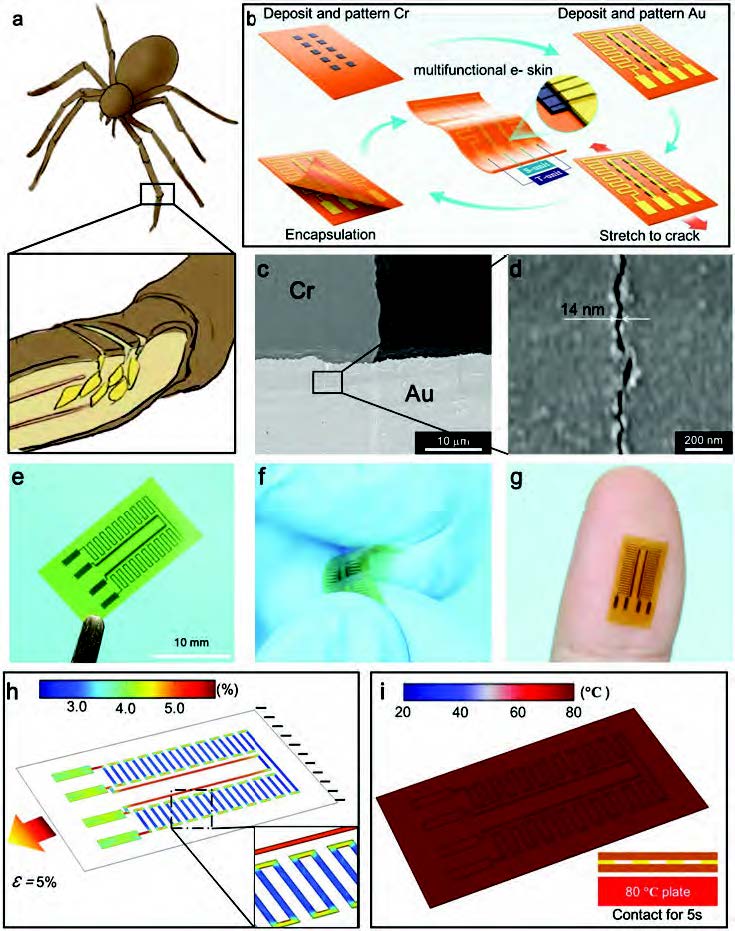| Oct 21, 2023 | |
Durable electronic skin sensors mimic capabilities of human skin |
|
| (Nanowerk Spotlight) Electronic skin, or e-skin, is an emerging technology that aims to mimic the sensing capabilities of human skin using flexible electronic materials and sensors. An exciting development in this field is the creation of multifunctional e-skins - versatile electronic skins that can simultaneously detect multiple stimuli like pressure, temperature, and humidity. | |
| Multifunctional e-skins integrate various types of sensors onto thin, stretchable substrates, allowing a single e-skin patch to monitor an array of environmental and physiological signals. This combination of flexibility and multi-sensing opens up potential applications for e-skins in robotics, prosthetics, and wearable health monitoring devices. | |
| While early versions of e-skins focused on single modalities like pressure mapping, new manufacturing techniques have enabled the integration of strain, temperature and even chemical sensors onto a single skin-like platform. The development of multifunctional e-skins represents a promising step toward truly smart synthetic skin. | |
 |
|
| The multifunctional e-skin manufactured by crack localized metal pattern. a) Schematic illustration of crack-shaped sensor organ of a spider. b) Schematic illustration of the fabrication process of the proposed multifunctional e-skin, in which, non-cracked serpentine-shaped Au film is used for temperature sensing (T-unit) and cracked strain Au electrode is used for strain sensing (S-unit), respectively. c) The SEM photos of the localized nanocrack pattern induced by the Cr layer. d) The width of the crack gap is 14 nm. e–g)The photo of e) the e-skin, f) under bending, and g) attached on a finger. h,i) the FEA simulation results of h) strain distribution and i) temperature variation. (Reprinted with permission by Wiley-VCH Verlag) | |
| Researchers from Dalian University of Technology have developed a flexible electronic skin that can sense touch and temperature, mimicking the capabilities of human skin. The e-skin uses robust polymers and a novel "crack localization" technique to create highly sensitive sensors that can withstand extreme conditions. | |
| The team published their findings in Small ("Bioinspired Environment-Adaptable and Ultrasensitive Multifunctional Electronic Skin for Human Healthcare and Robotic Sensations"). Human skin contains various receptors that allow it to sense pressure, temperature, and other stimuli. In recent years, researchers have worked to develop electronic skins (e-skins) with similar capabilities, with potential applications in robotics, prosthetics, and health monitoring. However, most current e-skins are designed for narrow temperature ranges and degrade in harsh environments. This restricts their use for applications like industrial robots that operate across a wide range of temperatures and conditions. | |
| To address this limitation, the researchers created an e-skin using polyimide, a polymer known for its thermal stability, chemical resistance, and mechanical strength. Polyimide provides significantly higher temperature tolerance compared to other polymers like silicone rubber and polyurethane commonly used in e-skin research. | |
| The key innovation enabling this durability is the researchers’ new “crack localization” technique for creating ultrasensitive strain gauges on the flexible polyimide substrate. They first pattern a brittle chromium layer to pre-define locations where cracks will form. A ductile gold conductor layer is then deposited on top. When the material stack is stretched, cracks form selectively in the gold layer above the patterned chromium, creating nanoscale gaps in the conductive gold traces. These gaps alter the electrical resistance of the gold, allowing minute strains to be detected. Surrounding undeformed gold traces act as temperature sensors. | |
| This crack localization method yielded strain gauges with sensitivity (gauge factor) over 80 times higher than conventional flexible strain sensors. Since both the strain and temperature sensing elements are made of gold, their temperature responses are identical, allowing temperature effects to be subtracted out from the strain signal. | |
| The researchers demonstrated potential applications of the durable, sensitive e-skin for health monitoring and robotics. When adhered to the throat, the e-skin could clearly distinguish normal breathing from patterns indicative of sleep apnea. Attached to the arm, it monitored subtle skin temperature changes and muscle deformations during exercise. Integrated on a soft robotic gripper, the e-skin sensed temperature and grip pressure, capabilities that persisted even when submerged in cold saline solution. | |
| While further development is needed to assess large-scale manufacturability, biocompatibility, and integration with data acquisition systems, this combination of robust construction and high sensitivity could significantly expand the range of conditions and applications for e-skin technologies. The authors suggest it could find uses in flexible touchscreens, human-machine interfaces, and a wide variety of demanding environments. With further development of sensing modalities and stretchable interconnects, durable high-performance e-skins may soon approach the capabilities of their biological counterparts. | |
 By
Michael
Berger
– Michael is author of three books by the Royal Society of Chemistry:
Nano-Society: Pushing the Boundaries of Technology,
Nanotechnology: The Future is Tiny, and
Nanoengineering: The Skills and Tools Making Technology Invisible
Copyright ©
Nanowerk LLC
By
Michael
Berger
– Michael is author of three books by the Royal Society of Chemistry:
Nano-Society: Pushing the Boundaries of Technology,
Nanotechnology: The Future is Tiny, and
Nanoengineering: The Skills and Tools Making Technology Invisible
Copyright ©
Nanowerk LLC
|
|
|
Become a Spotlight guest author! Join our large and growing group of guest contributors. Have you just published a scientific paper or have other exciting developments to share with the nanotechnology community? Here is how to publish on nanowerk.com. |
|
